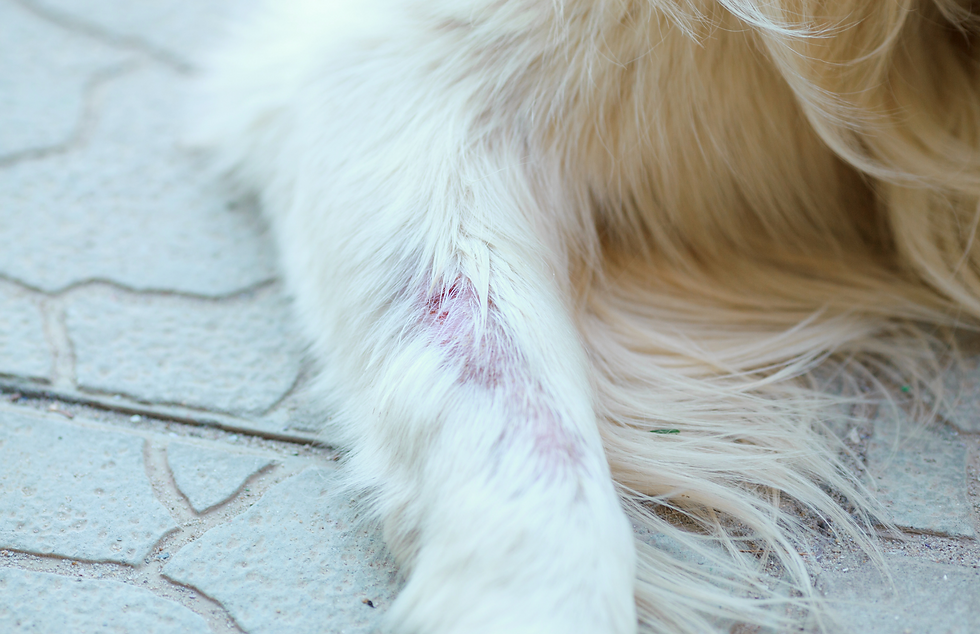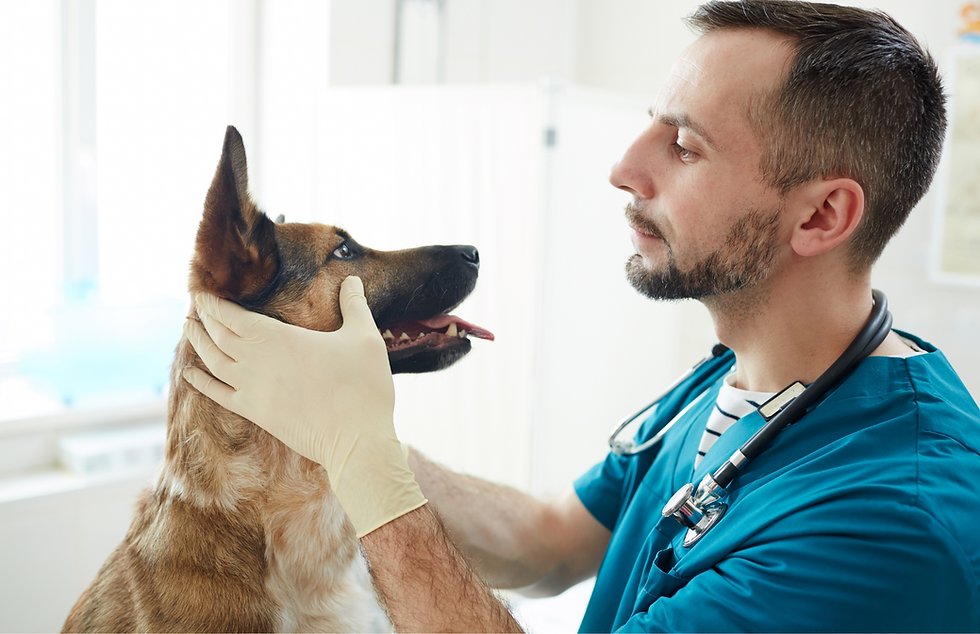Mastering Canine Allergies: Understanding, Management, and Prevention for Your Dog's Health
- Dr. Saba Afzal DVM

- Sep 20, 2021
- 17 min read
Updated: May 19, 2025

Are you concerned about your furry friend's health and suspect they might be suffering from allergies? Whether your vet has already diagnosed an allergy, or you've heard from fellow dog lovers about the importance of allergy testing, you're not alone. Allergies in dogs are real and can pose significant challenges to their well-being.
The world of canine allergies can be a bit of a mystery, leaving many pet owners in the dark about the various types and their telltale signs. In this comprehensive guide, we'll unravel the intricate web of allergies in dogs, exploring their different forms and how to treat them effectively. So, let's embark on this enlightening journey to better understand canine allergies, starting with the basics: What exactly is an allergy?
Understanding Allergies: Unmasking the Allergic Culprit in Dogs
Before we can effectively address allergies in dogs, it's essential to grasp the fundamentals of what an allergy is and how it manifests in our beloved canine companions. Allergies, whether in humans or dogs, are the result of the immune system's response to a perceived threat. Here, we'll demystify this process and explore its implications for dogs.
Immune System Alert
In essence, allergies are a manifestation of an overactive immune response. When a dog encounters a substance that their immune system deems potentially harmful (even if it's harmless to most dogs), the body goes on high alert. This substance, which triggers the allergic response, is called an allergen. Common allergens in dogs include pollen, certain foods, insect bites, and more.
The Role of Allergen Exposure

We'll discuss how exposure to allergens plays a pivotal role. It might not be a problem the first time a dog encounters a specific allergen. However, on subsequent exposures, the immune system may recognize it as a threat and mount an immune response. This is why dogs can develop allergies over time, even if they were not initially sensitive to a particular substance.
Allergic Reactions
To understand how allergies affect dogs, we'll outline the different types of allergic reactions, including immediate hypersensitivity reactions (such as hives and anaphylaxis) and delayed hypersensitivity reactions (like atopic dermatitis or food allergies). Each type of reaction has its own set of symptoms and treatment approaches.
Inflammatory Response
An integral part of allergic reactions is the release of inflammatory mediators, such as histamine. These substances cause various symptoms, from itching and redness to digestive upset. We'll explain how these responses contribute to the discomfort experienced by allergic dogs.
Genetics and Predisposition
Some dogs may be genetically predisposed to developing allergies. We'll explore how genetics can influence a dog's likelihood of developing allergies and why certain breeds are more susceptible than others.
By the end of this section, readers will have a clear understanding of the complex mechanisms underlying allergies in dogs. Armed with this knowledge, they will be better prepared to recognize the signs of allergies in their own pets and explore the various avenues for managing and treating these conditions effectively.
Types of Allergies in Dogs
When the immune system falsely recognizes the allergens and responds ill-logically, the allergy is caused. There are various types of canine allergies all around you. The most common ones are skin, food, and environmental allergies. The most confusing thing for humans regarding the allergy is their symptoms.
The allergies and their symptoms are overleaping, and they make it difficult for the parents to recognize them. Let's start reading about these types of allergies to know them better and react accordingly:
Skin Allergies
Dermatitis or skin allergy is the most common type which your canine buddy has to suffer from. Skin allergy is mostly caused by three different factors with the inclusion of food and environment. When the food and environmental agents affect the skin of your buddy, we add these to dermatitis. Following are the three types of canine allergies of skin:
Flea allergy dermatitis
Food allergy dermatitis
Environmental allergens dermatitis
Flea Allergy Dermatitis
Flea allergy dermatitis ranks high among the primary causes of skin allergies in dogs. This condition occurs when your dog encounters fleas, and the consequences can be particularly distressing.
Flea Bites and Scratching: When fleas infest your dog's skin, they'll inevitably bite and scratch, leading to the telltale signs of fleabites. It's essential to recognize that most dogs are not allergic to fleas themselves but to their saliva. The mere presence of fleas on your dog's skin is sufficient to send them into a frenzy of scratching.
Identification: One way to identify the presence of fleas is to closely inspect your dog's skin during bouts of intense scratching. You might spot small dark specks, commonly referred to as flea dirt, or even the fleas themselves.

Hot Spots: Flea allergy dermatitis often leads to the development of 'hot spots,' which are areas of the skin, typically located under the tail and beneath the stomach, that become inflamed, bloody, and intensely itchy due to persistent scratching.
Preventing Infections: In cases where the skin becomes raw from excessive scratching, it is imperative to act swiftly to prevent secondary bacterial infections. Seek immediate medication or consult with your veterinarian for guidance on how to relieve your dog's discomfort and tackle the underlying flea infestation.
Understanding and promptly addressing flea allergy dermatitis is crucial not only for your dog's comfort but also to prevent potential health complications that can arise from untreated skin conditions. Stay vigilant and take swift action if you suspect fleas are causing your dog's distress.
Food Allergy Dermatitis
Food allergies are a distinct category of skin allergies in dogs and are primarily triggered by specific proteins found in their diet. Understanding food allergy dermatitis is essential for pet owners, as it often presents unique challenges. Here, we'll explore the intricacies of this type of canine allergy:

Food Protein-Induced Allergic Reactions: Food allergies in dogs are characterized by an overactive immune response to certain proteins found in their diet. These proteins can be from various sources, such as chicken, beef, grains, or even more exotic ingredients.
Common Symptom Locations: One distinctive aspect of food allergies is that they often manifest in specific areas of the dog's body. The paws and the skin over the ears are common sites for these allergies to present themselves. Affected dogs may exhibit symptoms like redness, itching, and inflammation in these areas.
Gastrointestinal Symptoms: In addition to skin reactions, food allergies can also lead to gastrointestinal symptoms. These may include vomiting, diarrhea, and upset stomach. It's important to note that food allergies can affect both the skin and the digestive system simultaneously, making diagnosis more challenging.
Caution in Dietary Choices: Once you've identified a food that triggers an allergic reaction in your dog, it's imperative to exercise caution. Reintroducing the problematic food can exacerbate the condition. In some cases, repeated exposure to the allergenic food can lead to more severe reactions, making the allergy harder to manage.
Understanding food allergy dermatitis is crucial for responsible pet ownership. If you suspect your dog has a food allergy, it's recommended to work closely with your veterinarian to identify the specific allergen and develop a suitable dietary plan. This can help alleviate discomfort, prevent recurrent issues, and ensure your dog receives a balanced, allergen-free diet for a healthier life.
Environmental Allergy Dermatitis
Environmental allergy dermatitis, often referred to as atopic dermatitis or atopic allergy, is a prevalent type of skin allergy in dogs triggered by substances in the environment. These allergens can be challenging to identify but are critical to recognize for the well-being of your canine companion. Here's a closer look at environmental allergy dermatitis:

Common Allergens: Environmental allergies in dogs are typically provoked by substances like dust particles, pollen, and mold spores. These airborne allergens can be present throughout the year or may exhibit seasonal variations, depending on the specific triggers and your geographic location.
Similar Symptoms to Food Allergy: Like food allergies, environmental allergies can manifest with skin symptoms such as itching, redness, and inflammation. However, what sets environmental allergies apart is the specific pattern of itching and scratching in different areas of your dog's body.
Characteristic Itch Patterns: Dogs with environmental allergies often exhibit scratching on their wrists, ankles, muzzles, underarms, and around their eyes. Even their toes are not safe from the incessant itching. These patterns of scratching can be indicative of environmental allergy involvement.
Seasonal Variations: Pay close attention to when your dog's allergy symptoms occur. If you notice that the itching and discomfort tend to start or worsen during specific times of the year or under particular conditions, this can be a significant clue that environmental allergies are at play.
Consulting with your veterinarian is crucial when dealing with environmental allergies, as they can help you identify the specific triggers and develop an appropriate treatment plan. Managing these allergies may involve strategies such as allergen avoidance, medication, or immunotherapy to desensitize your dog's immune system. Understanding the distinctive features of environmental allergy dermatitis is vital to ensure the comfort and well-being of your canine companion, especially in cases where these allergies might be more challenging to pinpoint than food allergies.
Food Allergies
Food allergies in dogs can present themselves in a variety of ways, making them a complex and challenging condition to manage. Understanding the nuances of food allergies is crucial for any dog owner, as these allergies can have a profound impact on a dog's well-being. Here, we'll explore the different facets of food allergies, including their symptoms, potential severity, and the importance of cautious dietary introductions:

Symptoms of Food Allergies: Food allergies can manifest as dermatitis, gastrointestinal issues, or a combination of both. Dermatitis typically presents as skin symptoms, such as itching, redness, hives, and inflammation. Gastrointestinal issues may include vomiting, diarrhea, and overall digestive upset. The combination of these symptoms can significantly affect your dog's quality of life.
Anaphylactic Reactions: In some cases, food allergies can escalate to a severe and life-threatening condition known as anaphylaxis. Anaphylaxis is characterized by a rapid and extreme immune response to a specific allergen, leading to symptoms like severe difficulty breathing, swelling, and shock. Anaphylactic reactions are rare but can be fatal if not treated promptly.
Testing and Diagnosis: If you suspect your dog has a food allergy, it's crucial to consult with a veterinarian for proper testing and diagnosis. Allergy testing can help identify the specific food allergen responsible for the adverse reactions. This information is vital for developing a dietary plan that avoids the allergen.
Caution with Dietary Changes: When introducing new foods to your dog's diet, it's advisable to proceed with caution. To assess their tolerance to a new food, add a small amount gradually and observe for any signs of allergy or intolerance. This method, known as a food trial, can help ensure the safety of your canine friend.
Safety and Allergy Management: If your dog exhibits any allergic symptoms, such as itching or digestive distress, when trying a new food, it's essential to discontinue that food immediately. Allergen avoidance is the cornerstone of managing food allergies, and your veterinarian can provide guidance on developing a safe and allergen-free diet for your dog.
Understanding the complexities of food allergies, from their symptoms to the potential severity of reactions, is essential for protecting your dog's health. By working closely with your veterinarian and practicing cautious dietary introductions, you can help your canine companion enjoy a healthy and symptom-free life while minimizing the risks associated with food allergies.
Acute Allergic Reactions: When Urgent Action is Imperative
While allergic reactions in dogs can vary in their severity, it's crucial to be aware of acute allergic reactions, which can escalate rapidly and become life-threatening. Anaphylactic responses to allergens like bee stings or vaccines are rare but can have dire consequences if not managed promptly. In this section, we'll delve into the details of acute allergic reactions in dogs and the importance of vigilance and swift action:

Anaphylactic Responses: Anaphylaxis is an extreme and potentially fatal allergic reaction that can occur when a dog is exposed to a specific allergen. Common triggers for anaphylaxis in dogs include bee stings and certain vaccines. While these instances are rare, the potential risk is real, and as a dog owner, it's crucial to recognize the symptoms and take them seriously.
Swelling as an Initial Sign: One of the primary signs of anaphylaxis is swelling, particularly in the face or other body parts. The swelling can be rapid and severe, potentially leading to airway obstruction and breathing difficulties. It's a critical early warning sign that should never be ignored.
Itching and Discomfort: In some cases, severe itching and discomfort may accompany anaphylactic reactions. These symptoms can extend beyond the immediate site of the allergen exposure and affect the entire body. The dog may exhibit restlessness and distress, making the situation even more urgent.
Emergency Response: When faced with an acute allergic reaction, time is of the essence. Immediate action is vital. Rush your dog to the veterinarian or an emergency animal clinic as soon as possible. Veterinarians have the expertise and resources to provide life-saving treatment, such as epinephrine, antihistamines, and supportive care.
Preventive Measures: While anaphylactic reactions are rare, it's essential to minimize the risk by being cautious with new medications and vaccines. Discuss any concerns with your veterinarian, and if your dog has a known history of severe allergic reactions, your vet may recommend pre-medication to reduce the risk of anaphylaxis.
In summary, acute allergic reactions, although infrequent, are a serious concern for dog owners. It's crucial to remain vigilant and proactive in monitoring your dog for signs of swelling, itching, and distress, particularly after potential allergen exposure. When in doubt, never hesitate to seek immediate veterinary attention. The rapid response is often the key to saving your canine companion's life and ensuring their safety in the face of severe allergic reactions.
Signs and Symptoms of Allergies in Dogs: Decoding the Canine Red Flags
Recognizing the signs and symptoms of allergies in dogs is paramount for ensuring prompt relief and care. Allergies can manifest in various ways, affecting different systems in your dog's body. In this section, we'll explore the diverse range of red flags that may indicate allergies, from the common signs of itching and skin problems to gastrointestinal and respiratory symptoms.
Itching and Skin Problems:

Scratching: One of the most common signs of allergies in dogs is excessive scratching. Allergies can trigger relentless itching, and your dog may scratch, bite, or lick themselves excessively in response.
Redness and Inflammation: Allergic reactions often result in red, inflamed skin. You may notice areas of your dog's body that appear irritated, swollen, and uncomfortable.
Hives: Raised, red, and itchy welts, known as hives or urticaria, can appear on the skin due to allergic responses.
Hair Loss: Prolonged scratching and licking can lead to hair loss in affected areas, leaving bald patches on your dog's coat.
Gastrointestinal Issues:
Vomiting: Allergies, particularly food allergies, can lead to gastrointestinal symptoms such as vomiting. Your dog may regurgitate food or experience recurrent vomiting.
Diarrhea: Another common gastrointestinal symptom is diarrhea, which can be frequent, loose, and sometimes contain mucus or blood.
Upset Stomach: Dogs with allergies might exhibit signs of an upset stomach, including decreased appetite and discomfort.
Respiratory Symptoms:
Coughing: Respiratory allergies, often triggered by airborne allergens like pollen, can cause coughing in dogs. The cough may be persistent, dry, or productive.
Sneezing: Dogs with respiratory allergies may frequently sneeze, particularly when exposed to allergens in the environment.
Nasal Discharge: Allergic reactions can lead to nasal discharge, which may be clear or mucous-like.
Ear Infections:
Itchy Ears: Allergies can lead to ear irritation and itching, which, if left untreated, can progress to ear infections.
Ear Odor: Infected ears may emit a foul odor.
Paw Chewing and Face Rubbing:
Excessive Paw Chewing: Allergic dogs may chew their paws excessively, sometimes leading to sores or inflammation.
Face Rubbing: Dogs with facial itching may rub their faces against objects or the ground.
Watery Eyes:
Tear Staining: Allergies can lead to watery eyes and tear staining, which may result in discolored fur around the eyes.
Behavioral Changes:
Restlessness: Dogs in discomfort due to allergies may exhibit restlessness, agitation, or changes in behavior.
Understanding these red flags is crucial for timely intervention. If you observe any of these signs or symptoms in your dog, it's advisable to consult with your veterinarian for a thorough evaluation and diagnosis. Prompt identification and management of allergies can significantly improve your dog's comfort and overall well-being.
Diagnosis and Testing for Canine Allergies: Unraveling the Allergen Puzzle
Diagnosing allergies in dogs can be a complex process, but it's a critical step in providing effective treatment and relief for your furry friend. In this section, we'll explore the various methods and tests that veterinarians employ to pinpoint specific allergens and develop customized treatment plans for dogs suffering from allergies:

Clinical Evaluation: The diagnosis of allergies often begins with a comprehensive clinical evaluation of your dog. Your veterinarian will take a detailed medical history, inquire about your dog's symptoms, and perform a physical examination. This initial assessment helps rule out other potential health issues and provides valuable information to guide the diagnostic process.
Allergy Testing: To identify the specific allergens responsible for your dog's allergic reactions, your veterinarian may recommend various allergy tests. Two common methods are: a. Intradermal Testing: In this procedure, a small amount of suspected allergens is injected just beneath the dog's skin. Any allergic reactions, such as redness or swelling, can indicate the presence of allergies to those specific allergens. b. Blood Tests: Blood tests, including serologic or ELISA tests, can measure the levels of antibodies (IgE) in your dog's bloodstream in response to specific allergens. High levels of antibodies to certain allergens can suggest an allergic response.
Elimination Diets: Food allergies are typically diagnosed through elimination diets. This process involves feeding your dog a diet with novel or hydrolyzed protein sources and avoiding potential allergens for a set period. If the allergic symptoms subside during this period, your veterinarian may gradually reintroduce specific ingredients to pinpoint the allergen.
Skin Prick Tests: Similar to human allergy testing, skin prick tests can be conducted in some cases. Small amounts of allergens are applied to the skin's surface, and any allergic reactions are noted.
Patch Testing: In cases of suspected contact allergies, patch testing may be performed. This involves applying potential allergens to your dog's skin under occlusive patches and monitoring for reactions.
Response to Treatment: In some situations, your veterinarian may use a trial-and-error approach. They may prescribe allergy medications, such as antihistamines or corticosteroids, and observe how your dog responds. A positive response can indicate the presence of allergies.
Environmental Assessments: Your veterinarian may inquire about your dog's living environment and any changes or exposures that correlate with the onset of allergic symptoms. This information can provide valuable insights into potential environmental allergens.
Once the specific allergens are identified through these diagnostic methods, your veterinarian can create a tailored treatment plan. This may involve allergen avoidance, dietary changes, medications, immunotherapy (allergy shots), or a combination of these approaches. The goal is to provide your dog with effective relief from allergies, improving their overall quality of life.
Treatment and Management of Canine Allergies: Nurturing Your Dog's Comfort
Canine allergies can be an ongoing concern, but with the right strategies, they can be managed effectively, allowing your dog to lead a more comfortable and symptom-free life. In this section, we'll provide a comprehensive overview of the various methods for treating and managing allergies in dogs, covering dietary changes, medications, and lifestyle adjustments.
Dietary Changes:
Allergen Avoidance: For food allergies, the primary approach is allergen avoidance. Once the specific allergen is identified through diagnostic testing, you can modify your dog's diet to exclude that allergen.
Hydrolyzed Diets: Some dogs with food allergies may benefit from hydrolyzed protein diets, where the proteins are broken down into smaller, less allergenic molecules.
Novel Protein Diets: Another dietary approach is to introduce novel protein sources your dog has not previously been exposed to. This helps minimize the risk of allergic reactions.
Medications:
Antihistamines: Antihistamines are commonly used to relieve itching and allergic reactions. These medications can help alleviate mild to moderate allergy symptoms.
Corticosteroids: For more severe allergies or acute flare-ups, corticosteroids may be prescribed by your veterinarian to provide rapid relief. However, long-term use of these medications should be managed carefully due to potential side effects.
Immunosuppressants: In cases of severe allergies that do not respond to other treatments, immunosuppressants may be considered. These medications help control the immune system's response to allergens.
Allergy Shots (Immunotherapy):
Customized Treatment: Immunotherapy, commonly known as allergy shots, is a long-term approach for managing allergies. It involves administering small amounts of the identified allergens to your dog over time to desensitize their immune system.
Effectiveness:* Allergy shots can be highly effective in reducing allergy symptoms and may even lead to long-term remission in some cases.
Lifestyle Adjustments:
Allergen Avoidance: Identifying and minimizing exposure to environmental allergens can be essential. This may involve keeping your dog indoors during peak pollen seasons or using air purifiers to reduce allergen levels in your home.
Grooming and Bathing:* Regular grooming and bathing can help remove allergens from your dog's coat and skin, reducing the likelihood of allergic reactions.
Flea and Parasite Control:* Proper flea and parasite control is essential to prevent allergic reactions caused by insect bites.
Topical Treatments:
Shampoos and Rinses: Medicated shampoos and rinses can help alleviate skin symptoms and reduce itching.
Ear and Eye Drops:* In the case of ear and eye allergies, specialized drops can provide relief and help prevent secondary infections.
Monitoring and Maintenance:
Regular Vet Checkups: Periodic checkups with your veterinarian are crucial to monitor your dog's response to treatment and make any necessary adjustments.
Nutritional Support: Providing a well-balanced, high-quality diet can help support your dog's overall health and immune function.
By combining these treatment methods and making necessary lifestyle adjustments, you can effectively manage your dog's allergies and ensure their comfort. It's essential to work closely with your veterinarian to develop a personalized treatment plan tailored to your dog's specific needs and allergies. Regular communication with your vet and diligent management of your dog's condition will go a long way in providing them with the best possible quality of life.
Preventive Measures: Safeguarding Your Dog Against Allergies
Preventing allergies in dogs is a proactive approach to ensure their well-being and happiness. By adopting preventive measures, you can reduce the risk of allergies and promote a healthier, allergy-free life for your furry companion.

Balanced Diet and Nutrition: Start by providing your dog with a balanced and high-quality diet. Ensuring proper nutrition helps strengthen their immune system and overall health, reducing the likelihood of allergies. If your dog has known food allergies, avoid the allergenic ingredients in their diet and opt for hypoallergenic or novel protein sources.
Environmental Modifications: Identify common environmental allergens that affect dogs, such as pollen, dust, and mold spores. Implement strategies to minimize exposure during peak allergen seasons. This may include keeping your dog indoors, using air purifiers, and cleaning their living environment regularly. Regularly use flea and parasite control methods to prevent allergic reactions triggered by insect bites.
Grooming and Hygiene: Regular grooming practices can help remove allergens from your dog's coat and skin. Brushing, bathing, and keeping their fur clean can minimize the risk of skin allergies. Pay special attention to your dog's ears and eyes, as these areas are prone to allergies. Keep them clean and use specialized products recommended by your veterinarian to prevent allergic reactions.

Acupressure: Consider incorporating acupressure into your dog's routine. Acupressure is a non-invasive holistic therapy that focuses on applying pressure to specific points on your dog's body. It's believed to help balance their energy and improve overall health. Acupressure can be tailored to address specific allergy-related symptoms. For example, there are acupressure points that may help alleviate itching, calm skin inflammation, and support the immune system.
If you're interested in learning more about acupressure and how to apply it to support your own animals, be sure to check out our online course. Designed for both beginners and those looking to deepen their understanding, this course walks you through the foundations of acupressure, key points, and practical techniques you can start using right away. It’s a great way to confidently support your animal’s well-being from the comfort of home. Sign up today and start your journey into holistic animal care!
Regular Exercise and Mental Stimulation: Regular exercise and mental stimulation are vital for your dog's physical and mental health. A healthy, active lifestyle can contribute to a robust immune system and overall well-being.
Allergy Testing and Early Intervention: If you suspect that your dog may be prone to allergies, consult with your veterinarian for proactive allergy testing. Identifying potential allergens early can help you take preventive measures before allergies become severe.
By implementing these preventive measures in a holistic approach, you can significantly reduce the risk of allergies in your dog and provide them with a healthier, happier life. Combining a balanced diet, environmental control, grooming practices, acupressure, regular exercise, and early intervention can be your recipe for success in safeguarding your dog against allergies.
Conclusion: Nurturing a Happier, Healthier Life for Your Allergic Companion
In this journey through the intricate world of canine allergies, we've delved into the intricacies of understanding, identifying, and managing the diverse challenges that allergies can pose for our beloved four-legged friends. Armed with this knowledge, you're better equipped to provide the care, attention, and love your dog deserves to lead a comfortable and fulfilling life.
Remember that allergies are a shared experience in the pet-owner relationship, but they need not define it. Whether your dog faces food, environmental, or skin allergies, the key to their well-being lies in early recognition and effective management. Regular veterinary checkups, allergy testing when needed, and a tailored treatment plan can make a world of difference in keeping allergies under control.
In the grand tapestry of preventive measures, acupressure, and balanced nutrition, you'll discover the power to reduce the risk of allergies and enhance your dog's overall health.
As you embark on this journey with your canine companion, embrace the partnership with your veterinarian, cherish the moments of play and exploration, and prioritize the well-being of your furry friend. The path to a happier, healthier life for your allergic companion is one paved with love, understanding, and unwavering dedication.
May your days together be filled with wagging tails, bright eyes, and joyful romps, free from the discomfort of allergies, and filled with the boundless happiness that only a dog's unconditional love can bring.

#dogallergies #allergiesindogs #canine #dog #puppy #doggo #dogmom #dogdad #ilovedogs #polltopastern #acupressureforallergies #acupressure #holistic #health #doghealth #dogcare #happydog #healthydogs #dogdays



